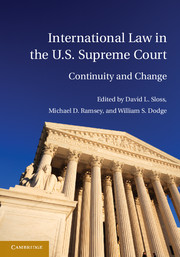Book contents
- Frontmatter
- Contents
- List of Contributors
- Table of Cases
- Acknowledgments
- Introduction
- PART I FROM THE FOUNDING TO THE CIVIL WAR
- PART II FROM THE CIVIL WAR TO THE TURN OF THE CENTURY
- PART III FROM THE TURN OF THE CENTURY TO WORLD WAR II
- PART IV FROM WORLD WAR II TO THE NEW MILLENNIUM
- PART V INTERNATIONAL LAW IN THE U.S. SUPREME COURT IN THE TWENTY-FIRST CENTURY
- V.A TREATIES AFTER 2000
- V.B CUSTOMARY INTERNATIONAL LAW AFTER 2000
- V.C INTERNATIONAL LAW AND CONSTITUTIONAL INTERPRETATION AFTER 2000
- V.D INTERNATIONAL LAW AND STATUTORY INTERPRETATION AFTER 2000
- V.E INTERNATIONAL LAW AND THE WAR ON TERROR
- VI CONCLUSION
- Continuity and Change over Two Centuries
- Index
- References
Continuity and Change over Two Centuries
Published online by Cambridge University Press: 05 July 2011
- Frontmatter
- Contents
- List of Contributors
- Table of Cases
- Acknowledgments
- Introduction
- PART I FROM THE FOUNDING TO THE CIVIL WAR
- PART II FROM THE CIVIL WAR TO THE TURN OF THE CENTURY
- PART III FROM THE TURN OF THE CENTURY TO WORLD WAR II
- PART IV FROM WORLD WAR II TO THE NEW MILLENNIUM
- PART V INTERNATIONAL LAW IN THE U.S. SUPREME COURT IN THE TWENTY-FIRST CENTURY
- V.A TREATIES AFTER 2000
- V.B CUSTOMARY INTERNATIONAL LAW AFTER 2000
- V.C INTERNATIONAL LAW AND CONSTITUTIONAL INTERPRETATION AFTER 2000
- V.D INTERNATIONAL LAW AND STATUTORY INTERPRETATION AFTER 2000
- V.E INTERNATIONAL LAW AND THE WAR ON TERROR
- VI CONCLUSION
- Continuity and Change over Two Centuries
- Index
- References
Summary
The history of international law in the U.S. Supreme Court from the Court's inception to 2010 has seen much continuity and much change. The Court's international law decisions during the first decade of the twenty-first century highlight these themes – deciding new questions and revisiting old ones, sometimes adhering to past precedents and sometimes abandoning them. Drawing on the contributions to this volume, this Conclusion summarizes the most significant ways in which the Court's approach to international law has remained constant and the most important ways in which it has changed over the course of more than 200 years. The analysis suggests that the pace of change has accelerated over time, with the nineteenth century dominated by continuity, the early twentieth century marked by a mixture of continuity and change, and the post–World War II era characterized by sweeping changes. Although different doctrinal changes occurred at different times, there are few aspects of the Supreme Court's international law doctrine that remain the same in the twenty-first century as they were 200 years ago.
Treaties
The Supreme Court's approach to treaties shows substantial continuity until the middle of the twentieth century, with substantial change occurring after World War II. In Ware v. Hylton, decided in 1796, the Court embraced the then-novel idea, reflected in the Constitution's Article VI, that treaties should function directly as domestic law, giving rise to judicially enforceable rights. Throughout the nineteenth and early twentieth centuries, the Court routinely applied treaties to preempt state law.
- Type
- Chapter
- Information
- International Law in the U.S. Supreme Court , pp. 589 - 606Publisher: Cambridge University PressPrint publication year: 2011



